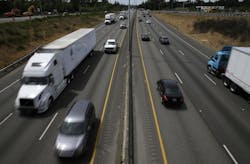Report finds stretch of I-5 tops for deployment of autonomous trucks
A report claims Interstate 5 between northern California and the Canadian border is the strongest corridor for the initial deployment of autonomous trucks.
The report from Inrix, a Washington-based company that provides connected vehicle services and transportation analytics, said that long stretch is tops because of its lower congestion rates, strong freight volumes.
Florida’s Interstate 95 between Jacksonville and Miami is second, Inrix said. Despite its shorter length, it too has high freight volumes and low congestion.
Inrix’s full report looked individually at a number of countries and found “the United States exhibits strong potential for HAV deployment due to increasing freight demand coupled with a shrinking labor pool.”
“Based on the high number of long-distance routes, decreasing labor costs and progress towards a unified regulatory framework, the United States holds exceptional promise for the deployment of automated freight,” the report said.
The report also found Interstate 75 between Atlanta to Chattanooga, TN, could reap the largest safety benefits from the implementation of automation and advanced technologies.
“Its high freight volume coupled with high incident rate differentiated it from other corridors that exhibited higher incidents per mile or overall volumes,” the report said. “It is followed by I-45 (Houston to Dallas) based on the route’s incident rate which exceeds all other American corridors studied by at least 10%.”
One potential negative for the United States, Inrix said, is actually just how many highways where autonomous vehicles may soon be able to travel.
“The large number of roadway options in itself could prove an impediment to adoption at scale as the industry is less likely to reach consensus around a limited number of corridors for early deployment, potentially leading to a fragmented approach,” the report said.
About the Author
Neil Abt
Neil Abt is a former FleetOwner editor who wrote for the publication from 2017 to 2020. He was editorial director from 2018 to 2020.
